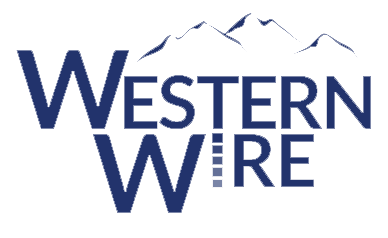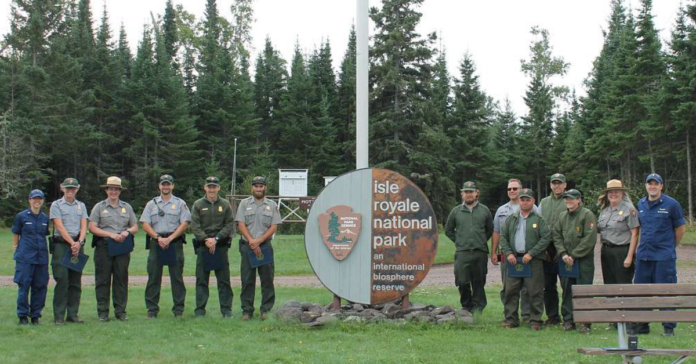The head of the Department of Interior said this week that addressing maintenance backlogs and being “creative” with National Park Service sites, particularly in the West, would support the nation’s economic growth and revive a faltering infrastructure that did not serve visitors with “world-class” experiences.
Following a keynote question-and-answer to the Western Governors’ Association annual meeting in Vail, Colo., Interior Secretary David Bernhardt sat down with Western Wire staff to discuss the National Park Service maintenance backlog and the need to be flexible in light of future growth in park visits and wear-and-tear of park infrastructure.
National Park Maintenance Backlog
Bernhardt’s assessment of the National Parks’ $12 billion maintenance backlog begins against the backdrop of the 318 million visitors who flocked to parks and other properties within the National Park System in 2018 alone.
“So, they had all this buildup before the parks’ centennial and all these things, and they went out and told the world, ‘hey, come to the parks, come to the parks!’ Fantastic. You know what they didn’t do? They didn’t put an ounce of infrastructure into making it [accessible],” said Bernhardt. “How are we going to deal with all of these people? So our structure is not set up. And what we need to do is really be creative in that department,” he added.
The recently released National Park Visitor Spending Effects report estimated $20.2 billion spent in communities located within 60 miles of a park, supporting 268,000 jobs within these “gateway” communities.
Bernhardt said that he believed strongly that the NPS should “provide visitors, both local and destination, with innumerous recreational, inspirational, and world-class experiences.”
The goal of addressing the backlog and adopting a forward-looking approach to accommodating the millions of visitors each year meant not “disappointing” residents and tourists alike, many of whom fly and then drive hundreds of miles to access national parks and other facilities, especially in the west.
The first priority, Bernhardt said, is tackling a backlog that is not only substantial in dollar terms but has been known for years and continues to await Congressional action.
“Number one, the maintenance backlog is significant, what’s amazing is that when I was here ten years ago, we thought it was a gigantic problem and we were telling everybody about it. Now, it’s just a bigger problem,” he said.
The latest figures for deferred maintenance at NPS parks and recreation areas, through September 2018, reveal staggering numbers for already crowded parks. Arizona has $507 million in deferred maintenance backlogs, with $313 million for the Grand Canyon National Park alone.
Several of the states in the west have backlogs reaching into the hundreds of millions of dollars each: California, $1.889 billion; Colorado, $247 million; Montana, $187 million; New Mexico, $121 million; Nevada, $252 million; Utah, $219 million; Washington, $427 million; and Wyoming, $771 million.
Bipartisan legislation to set aside up to $6.5 billion for addressing the maintenance backlog has been introduced. The “Restore Our Parks Act” from Sen. Rob Portman (R-Ohio) would allocate an “amount equal to 50 percent of all energy development revenues due and payable to the United States from oil, gas, coal, or alternative or renewable energy development on Federal land and water” up to $1.3 billion per year, between 2019 and 2023.
The companion House bill, H.R. 1225, has more than 220 House co-sponsors.
Bernhardt said that while there were significant disagreements expressed as he went through his confirmation process earlier this year, the one area where there was strong agreement on action was funding the maintenance backlog.
“I went through this confirmation process. There is a lot of disagreement in your confirmation process. For one thing, I met with over 41 senators.
Everyone one of them, when I brought up this backlog, they were like, ‘oh yea, we need to do something about it.’ So, I think it’s really nudging them and getting them to work with us to do something,” he said.
To that end, Vice President Mike Pence would be visiting Yellowstone National Park Thursday to highlight these issues.
“My view is just that we just need to press harder to see if we can get something done. The only I know is that if we don’t, it’ll just be bigger. And we’re doing some other creative things. We’ve raised entrance fees, it’s still an incredible bargain.
We raised fees so that raises some additional money to do some things like enhancing visitors’ experience,” Bernhardt said. He has been advising parks to “use those fees if you addressed your maintenance backlog.
You can use those fees to hire additional staff. We just have to move into a world where we try to make the parks more sustainable,” he added.
The investments are worth it in the eyes of the Interior Department—not only to enhance and deliver a quality experience for everyone who visits—but because of the tremendous economic benefits the states receive from parks-related tourism, investment, and spending.
A Western Wire state-by-state analysis in May of National Park contributions to western states shows $1.3 billion in economic contributions to Arizona, followed by $1.2 billion in Utah, $928 million for Wyoming, $633 million for Montana, and $497 million for Colorado.
Individual parks within the states constitute huge economic engines locally and regionally. Grand Canyon National Park in Arizona generated $947 million in 2018, followed Wyoming’s Grand Teton National Park and Yellowstone National Park at $629 million and $513 million, respectively.
Colorado’s Rocky Mountain National Park drew $306 million in visitor spending. Popular national recreation areas like Glen Canyon ($411 million) and Lake Mead ($336 million) also drew tremendous tourist spending.
Overall, that led to $6.8 billion in lodging revenues and another $4 billion for restaurants and bars.
Addressing maintenance backlogs alone does not reveal the whole picture, according to Bernhardt.
He pointed to facilities, and even the spacing of parking lot spaces, that may not need to simply be refurbished or repainted, but rethought, given the age of the building or the different era when vehicles or trailers were much, much smaller.
“The other thing is in terms of infrastructure, a lot of our campgrounds and stuff, they were built with a concept of a campground in 1962 and since then, things like travel trailers or RVs, and frankly, even my Tahoe, they’re all bigger, right?” Bernhardt said.
Pulloffs for vehicles at western parks, like Bryce Canyon National Park, might have originally been constructed with a handful of vehicles—cars, specifically—in mind. Now those pulloffs are populated by larger vehicles and SUVs, pickups, and RVs.
So instead of 5-7 cars, Bernhardt said, only 2-3 larger vehicles can use the enhancement, leaving ever-increasing crowds in search of space to park to visit well-known features, clogging up the roads or damaging critical habitat inadvertently.
In addition, the modern traveler has a much different national park experience in mind, Bernhardt said.
“The amenities that people want have changed. Now they want a water hookup or a good degree of electricity.
So, I think we need to be thoughtful about that. I think we need more parking lots, to be completely honest,” he said. “I’ve seen trailheads that you used to be able to pull off, and then you go up [and hike], and now people are hiking like four miles to get to the trailhead, and then they’re supposed to go on the actual hike.
Great people do that. But most of the people are like me. We’re done by the time we get there,” he said.
Bernhardt included accessibility for the disabled, as all parks should be open to everyone. Not being able to accommodate visitors, whether weekend warriors who live nearby or the 15 to 20 percent of visitors from other countries is a non-starter for the secretary, including the recent government shutdown.
“This is insane,” he said. “Like, that took a long time to fly, to drive, to make the trip. And then we’re closed, and it’s a really bad experience.”
Bernhardt told Western Wire that enhancing the experience should lead to consideration of other options, beginning with maintenance, but also in looking at other ways that revenue could be used to improve the overall National Park offering.
“So we have to up our game. And we have to have some help on maintenance. And we also have to become a little more creative with fees.
For example, looking at charging more for certain amenities,” he said, along with time of year fee-based schedule, given the seasonality of some parks, like those in the west who see the vast majority of their visits between May and September.

